Exploring International Business Strategies: Success Factors and Challenges
VerifiedAdded on 2019/09/23
|7
|1987
|482
Report
AI Summary
This assignment discusses the importance of strategic decision-making for organizations to achieve success in international competition. It highlights the role of government policies and market entry modes in facilitating or hindering business expansion. The discussion draws from four journal articles, which analyze different aspects of internationalization, including country selection, privatization, and market entry decisions.
Contribute Materials
Your contribution can guide someone’s learning journey. Share your
documents today.
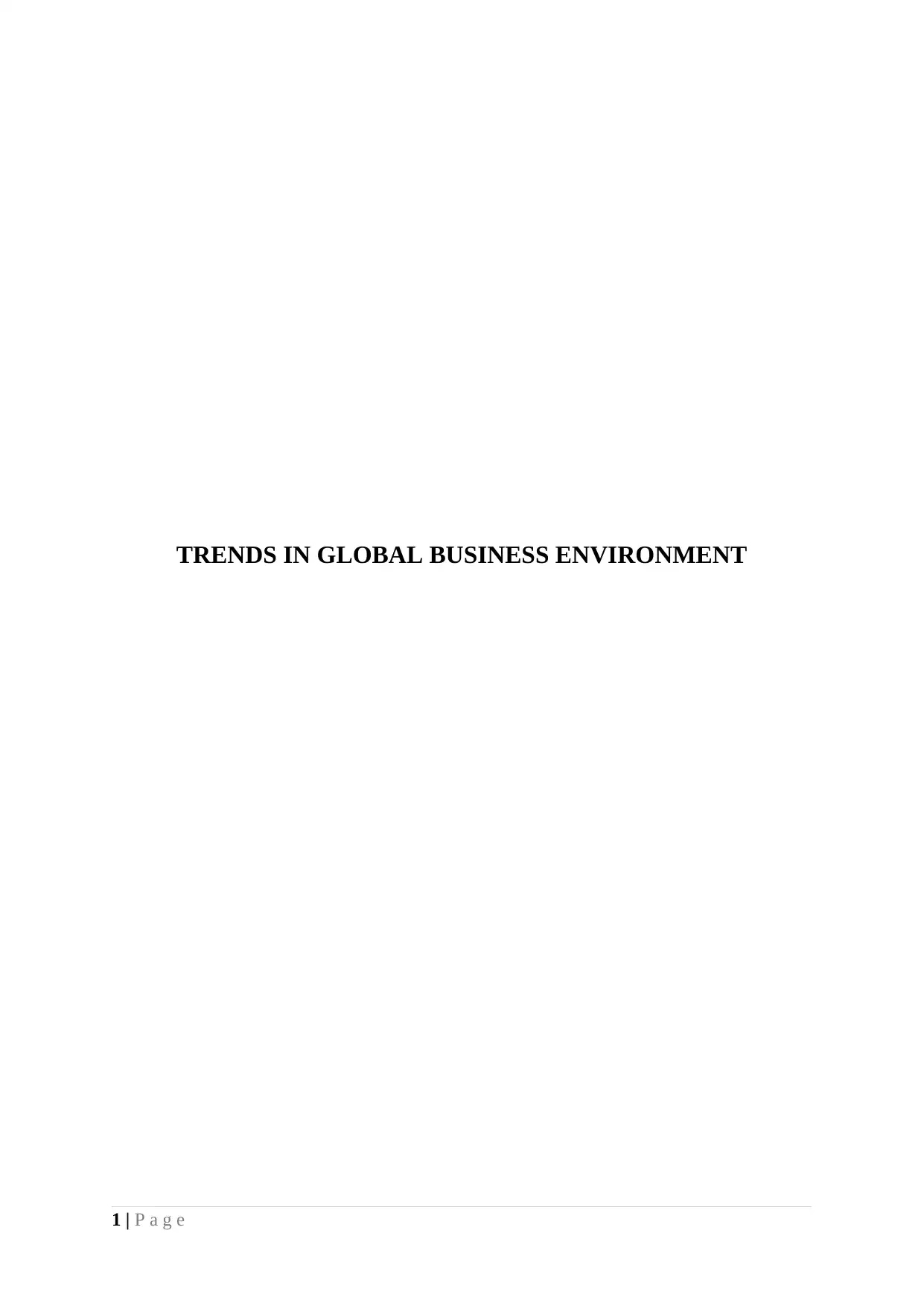
TRENDS IN GLOBAL BUSINESS ENVIRONMENT
1 | P a g e
1 | P a g e
Secure Best Marks with AI Grader
Need help grading? Try our AI Grader for instant feedback on your assignments.
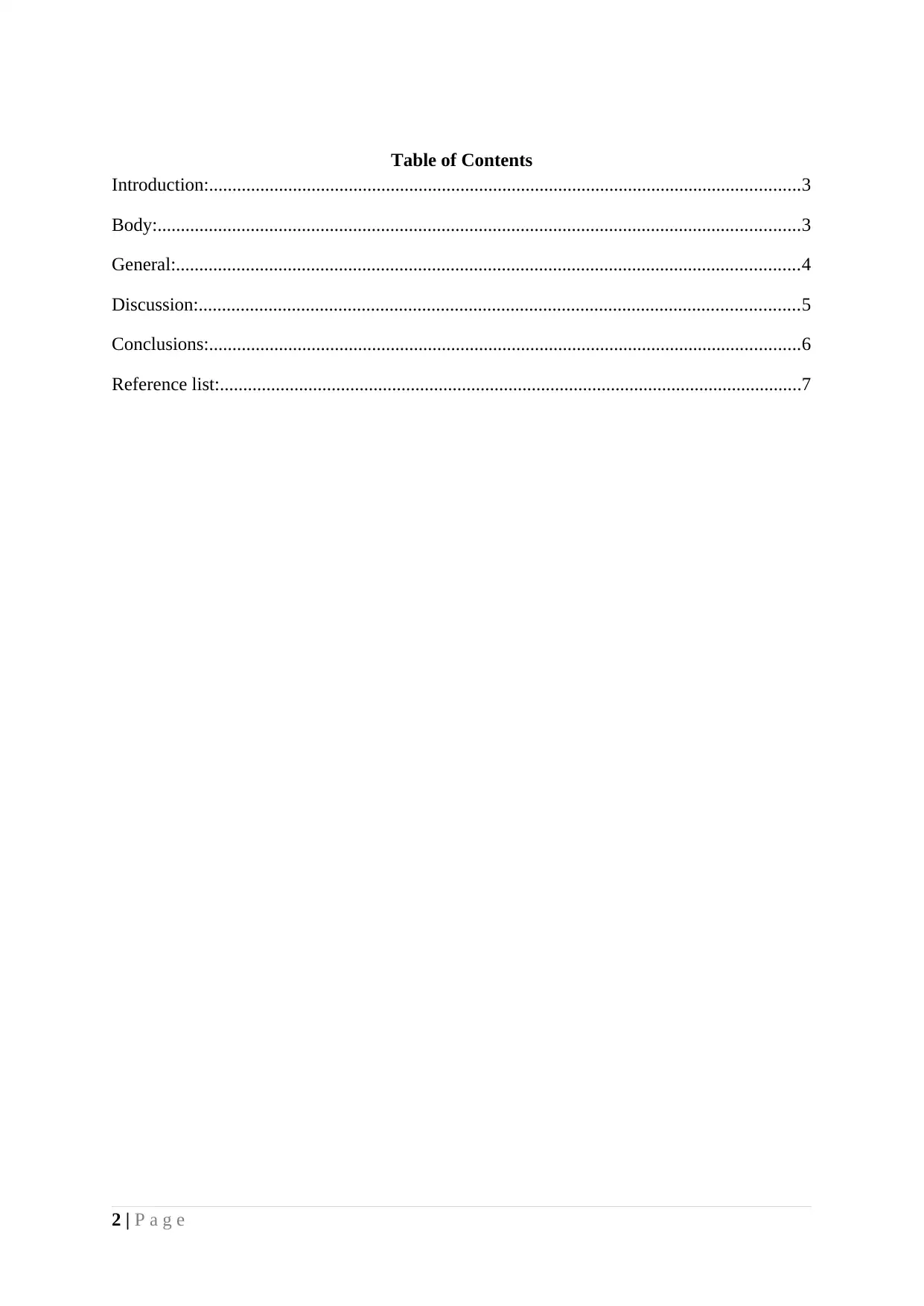
Table of Contents
Introduction:...............................................................................................................................3
Body:..........................................................................................................................................3
General:......................................................................................................................................4
Discussion:.................................................................................................................................5
Conclusions:...............................................................................................................................6
Reference list:.............................................................................................................................7
2 | P a g e
Introduction:...............................................................................................................................3
Body:..........................................................................................................................................3
General:......................................................................................................................................4
Discussion:.................................................................................................................................5
Conclusions:...............................................................................................................................6
Reference list:.............................................................................................................................7
2 | P a g e
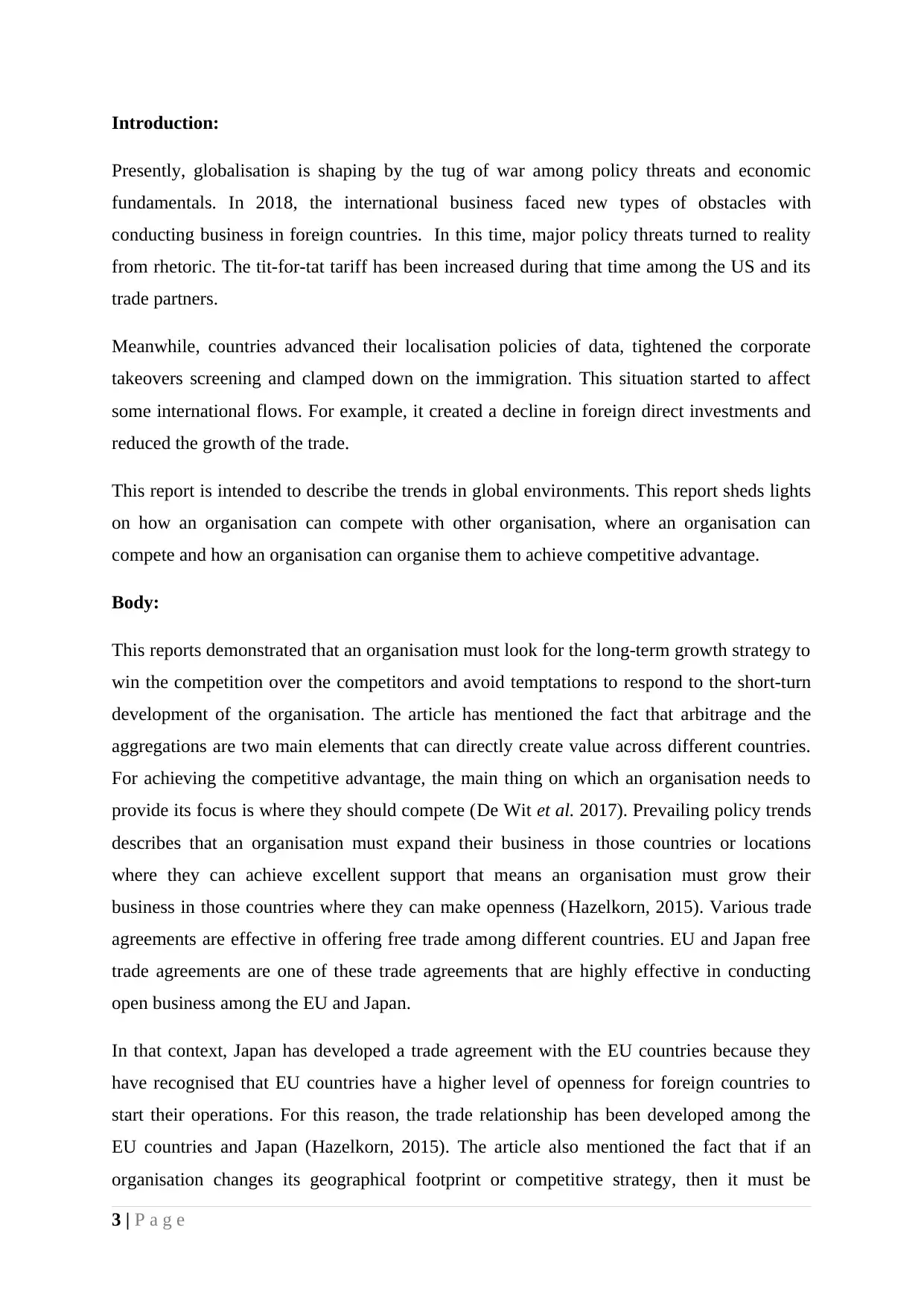
Introduction:
Presently, globalisation is shaping by the tug of war among policy threats and economic
fundamentals. In 2018, the international business faced new types of obstacles with
conducting business in foreign countries. In this time, major policy threats turned to reality
from rhetoric. The tit-for-tat tariff has been increased during that time among the US and its
trade partners.
Meanwhile, countries advanced their localisation policies of data, tightened the corporate
takeovers screening and clamped down on the immigration. This situation started to affect
some international flows. For example, it created a decline in foreign direct investments and
reduced the growth of the trade.
This report is intended to describe the trends in global environments. This report sheds lights
on how an organisation can compete with other organisation, where an organisation can
compete and how an organisation can organise them to achieve competitive advantage.
Body:
This reports demonstrated that an organisation must look for the long-term growth strategy to
win the competition over the competitors and avoid temptations to respond to the short-turn
development of the organisation. The article has mentioned the fact that arbitrage and the
aggregations are two main elements that can directly create value across different countries.
For achieving the competitive advantage, the main thing on which an organisation needs to
provide its focus is where they should compete (De Wit et al. 2017). Prevailing policy trends
describes that an organisation must expand their business in those countries or locations
where they can achieve excellent support that means an organisation must grow their
business in those countries where they can make openness (Hazelkorn, 2015). Various trade
agreements are effective in offering free trade among different countries. EU and Japan free
trade agreements are one of these trade agreements that are highly effective in conducting
open business among the EU and Japan.
In that context, Japan has developed a trade agreement with the EU countries because they
have recognised that EU countries have a higher level of openness for foreign countries to
start their operations. For this reason, the trade relationship has been developed among the
EU countries and Japan (Hazelkorn, 2015). The article also mentioned the fact that if an
organisation changes its geographical footprint or competitive strategy, then it must be
3 | P a g e
Presently, globalisation is shaping by the tug of war among policy threats and economic
fundamentals. In 2018, the international business faced new types of obstacles with
conducting business in foreign countries. In this time, major policy threats turned to reality
from rhetoric. The tit-for-tat tariff has been increased during that time among the US and its
trade partners.
Meanwhile, countries advanced their localisation policies of data, tightened the corporate
takeovers screening and clamped down on the immigration. This situation started to affect
some international flows. For example, it created a decline in foreign direct investments and
reduced the growth of the trade.
This report is intended to describe the trends in global environments. This report sheds lights
on how an organisation can compete with other organisation, where an organisation can
compete and how an organisation can organise them to achieve competitive advantage.
Body:
This reports demonstrated that an organisation must look for the long-term growth strategy to
win the competition over the competitors and avoid temptations to respond to the short-turn
development of the organisation. The article has mentioned the fact that arbitrage and the
aggregations are two main elements that can directly create value across different countries.
For achieving the competitive advantage, the main thing on which an organisation needs to
provide its focus is where they should compete (De Wit et al. 2017). Prevailing policy trends
describes that an organisation must expand their business in those countries or locations
where they can achieve excellent support that means an organisation must grow their
business in those countries where they can make openness (Hazelkorn, 2015). Various trade
agreements are effective in offering free trade among different countries. EU and Japan free
trade agreements are one of these trade agreements that are highly effective in conducting
open business among the EU and Japan.
In that context, Japan has developed a trade agreement with the EU countries because they
have recognised that EU countries have a higher level of openness for foreign countries to
start their operations. For this reason, the trade relationship has been developed among the
EU countries and Japan (Hazelkorn, 2015). The article also mentioned the fact that if an
organisation changes its geographical footprint or competitive strategy, then it must be
3 | P a g e

adjusted with the organisational architecture of the organisation. According to the article, it is
always necessary for an organisation in strengthening its research and development to
achieve a competitive advantage. For attaining a competitive advantage, an organisation must
engage their organisation with society. For this purposes, it is necessary for an organisation in
emphasising the real benefits of the organisation to the target markets so that customers can
be attracted to use the products of an organisation by identifying the value. An organisation
must not facilitate false promises or allegiances because of it carets a negative perception
among customers which destroys the brand image of an organisation.
General:
Keywords for this report are free to trade policies among countries, political and economic
openness to expanding the business, Country selection for internationalisation, international
market entry to achieve success.
According to the first article that is "the North American free trade agreements" a brief
overview of the free trade agreement is possible. According to the report, NAFTA was signed
by the presidents in the year of 1992. This free trade policy was approved to eliminate most
of the trade barriers and tariffs among USA, Mexico and Canada. However, after the
selection of Donald Trump as the prime minister of the US, the situation has been changed
(Panayotou, 2016). The trade was developed by considering the view that free trade
agreements in North America would increase the production and business which can create
millions of well-paying jobs (Panayotou, 2016). Donald Trump has stated his desire in
renegotiating NAFTA, and after that, he also demonstrated that he would examine the
process of withdrawal of NAFTA after he entered into office. Trump has also raised the
possibilities to impose some border tax on the border of Mexico so that he can control or stop
the trade in the border of Mexico. This report provides a brief overview of the provision of
NAFTA agreements, the economic effects of NAFTA and the policy considerations
associated with NAFTA.
The paper “openness, international champions and internationalisation of mutilatinas” offers
a brief overview about how a state can attract the vast number of different organisations with
the help of preferable strategies (Hennart, Sheng, & Carrera Jr, 2017). This paper has
provided a brief overview of why Latin Americans have carried out the policies for
developing state-owned enterprises and abandoned their import-substituting industrialisation
(Hennart, Sheng, & Carrera Jr, 2017). The main reason behind developing strategies to attract
4 | P a g e
always necessary for an organisation in strengthening its research and development to
achieve a competitive advantage. For attaining a competitive advantage, an organisation must
engage their organisation with society. For this purposes, it is necessary for an organisation in
emphasising the real benefits of the organisation to the target markets so that customers can
be attracted to use the products of an organisation by identifying the value. An organisation
must not facilitate false promises or allegiances because of it carets a negative perception
among customers which destroys the brand image of an organisation.
General:
Keywords for this report are free to trade policies among countries, political and economic
openness to expanding the business, Country selection for internationalisation, international
market entry to achieve success.
According to the first article that is "the North American free trade agreements" a brief
overview of the free trade agreement is possible. According to the report, NAFTA was signed
by the presidents in the year of 1992. This free trade policy was approved to eliminate most
of the trade barriers and tariffs among USA, Mexico and Canada. However, after the
selection of Donald Trump as the prime minister of the US, the situation has been changed
(Panayotou, 2016). The trade was developed by considering the view that free trade
agreements in North America would increase the production and business which can create
millions of well-paying jobs (Panayotou, 2016). Donald Trump has stated his desire in
renegotiating NAFTA, and after that, he also demonstrated that he would examine the
process of withdrawal of NAFTA after he entered into office. Trump has also raised the
possibilities to impose some border tax on the border of Mexico so that he can control or stop
the trade in the border of Mexico. This report provides a brief overview of the provision of
NAFTA agreements, the economic effects of NAFTA and the policy considerations
associated with NAFTA.
The paper “openness, international champions and internationalisation of mutilatinas” offers
a brief overview about how a state can attract the vast number of different organisations with
the help of preferable strategies (Hennart, Sheng, & Carrera Jr, 2017). This paper has
provided a brief overview of why Latin Americans have carried out the policies for
developing state-owned enterprises and abandoned their import-substituting industrialisation
(Hennart, Sheng, & Carrera Jr, 2017). The main reason behind developing strategies to attract
4 | P a g e
Paraphrase This Document
Need a fresh take? Get an instant paraphrase of this document with our AI Paraphraser
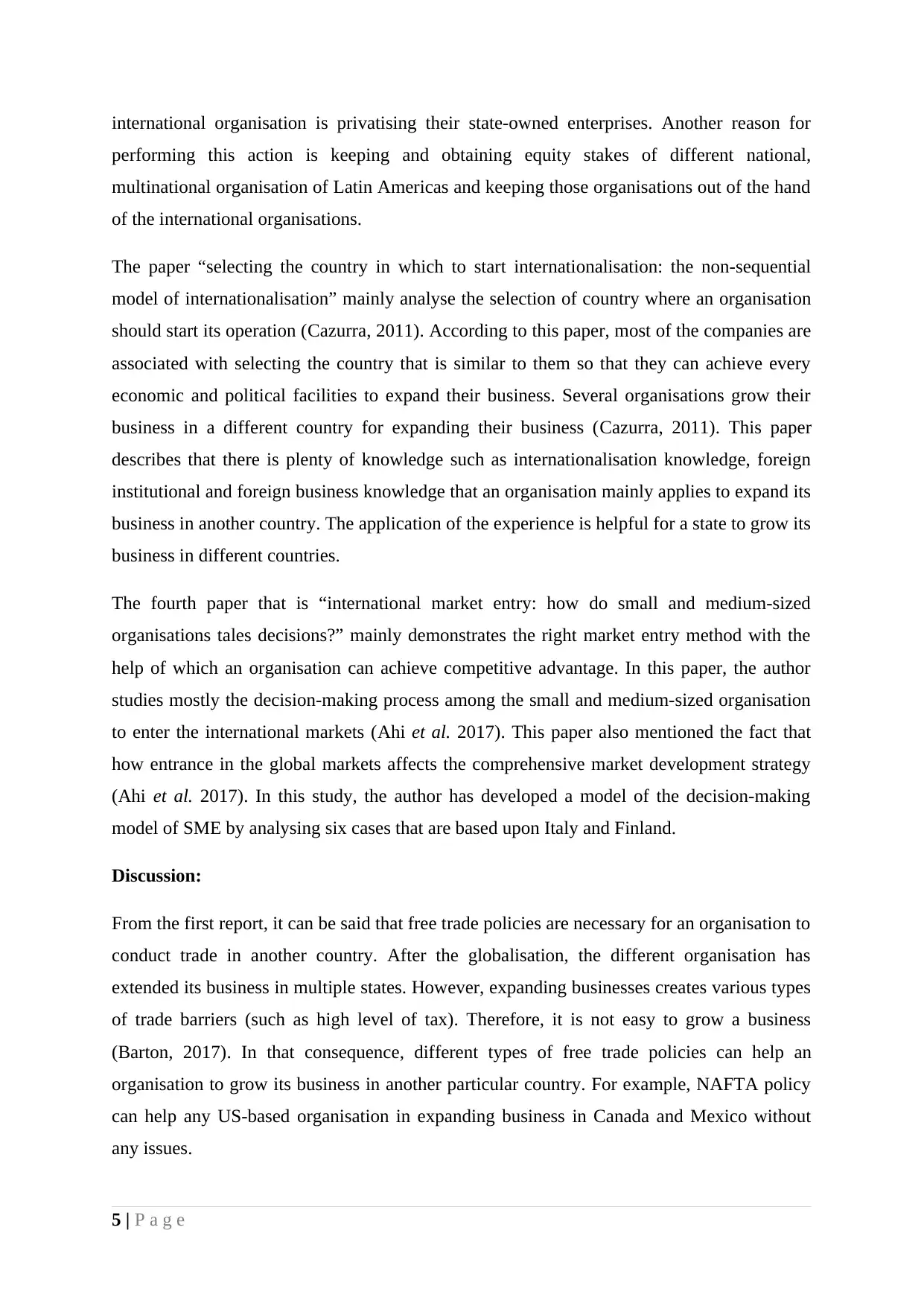
international organisation is privatising their state-owned enterprises. Another reason for
performing this action is keeping and obtaining equity stakes of different national,
multinational organisation of Latin Americas and keeping those organisations out of the hand
of the international organisations.
The paper “selecting the country in which to start internationalisation: the non-sequential
model of internationalisation” mainly analyse the selection of country where an organisation
should start its operation (Cazurra, 2011). According to this paper, most of the companies are
associated with selecting the country that is similar to them so that they can achieve every
economic and political facilities to expand their business. Several organisations grow their
business in a different country for expanding their business (Cazurra, 2011). This paper
describes that there is plenty of knowledge such as internationalisation knowledge, foreign
institutional and foreign business knowledge that an organisation mainly applies to expand its
business in another country. The application of the experience is helpful for a state to grow its
business in different countries.
The fourth paper that is “international market entry: how do small and medium-sized
organisations tales decisions?” mainly demonstrates the right market entry method with the
help of which an organisation can achieve competitive advantage. In this paper, the author
studies mostly the decision-making process among the small and medium-sized organisation
to enter the international markets (Ahi et al. 2017). This paper also mentioned the fact that
how entrance in the global markets affects the comprehensive market development strategy
(Ahi et al. 2017). In this study, the author has developed a model of the decision-making
model of SME by analysing six cases that are based upon Italy and Finland.
Discussion:
From the first report, it can be said that free trade policies are necessary for an organisation to
conduct trade in another country. After the globalisation, the different organisation has
extended its business in multiple states. However, expanding businesses creates various types
of trade barriers (such as high level of tax). Therefore, it is not easy to grow a business
(Barton, 2017). In that consequence, different types of free trade policies can help an
organisation to grow its business in another particular country. For example, NAFTA policy
can help any US-based organisation in expanding business in Canada and Mexico without
any issues.
5 | P a g e
performing this action is keeping and obtaining equity stakes of different national,
multinational organisation of Latin Americas and keeping those organisations out of the hand
of the international organisations.
The paper “selecting the country in which to start internationalisation: the non-sequential
model of internationalisation” mainly analyse the selection of country where an organisation
should start its operation (Cazurra, 2011). According to this paper, most of the companies are
associated with selecting the country that is similar to them so that they can achieve every
economic and political facilities to expand their business. Several organisations grow their
business in a different country for expanding their business (Cazurra, 2011). This paper
describes that there is plenty of knowledge such as internationalisation knowledge, foreign
institutional and foreign business knowledge that an organisation mainly applies to expand its
business in another country. The application of the experience is helpful for a state to grow its
business in different countries.
The fourth paper that is “international market entry: how do small and medium-sized
organisations tales decisions?” mainly demonstrates the right market entry method with the
help of which an organisation can achieve competitive advantage. In this paper, the author
studies mostly the decision-making process among the small and medium-sized organisation
to enter the international markets (Ahi et al. 2017). This paper also mentioned the fact that
how entrance in the global markets affects the comprehensive market development strategy
(Ahi et al. 2017). In this study, the author has developed a model of the decision-making
model of SME by analysing six cases that are based upon Italy and Finland.
Discussion:
From the first report, it can be said that free trade policies are necessary for an organisation to
conduct trade in another country. After the globalisation, the different organisation has
extended its business in multiple states. However, expanding businesses creates various types
of trade barriers (such as high level of tax). Therefore, it is not easy to grow a business
(Barton, 2017). In that consequence, different types of free trade policies can help an
organisation to grow its business in another particular country. For example, NAFTA policy
can help any US-based organisation in expanding business in Canada and Mexico without
any issues.
5 | P a g e
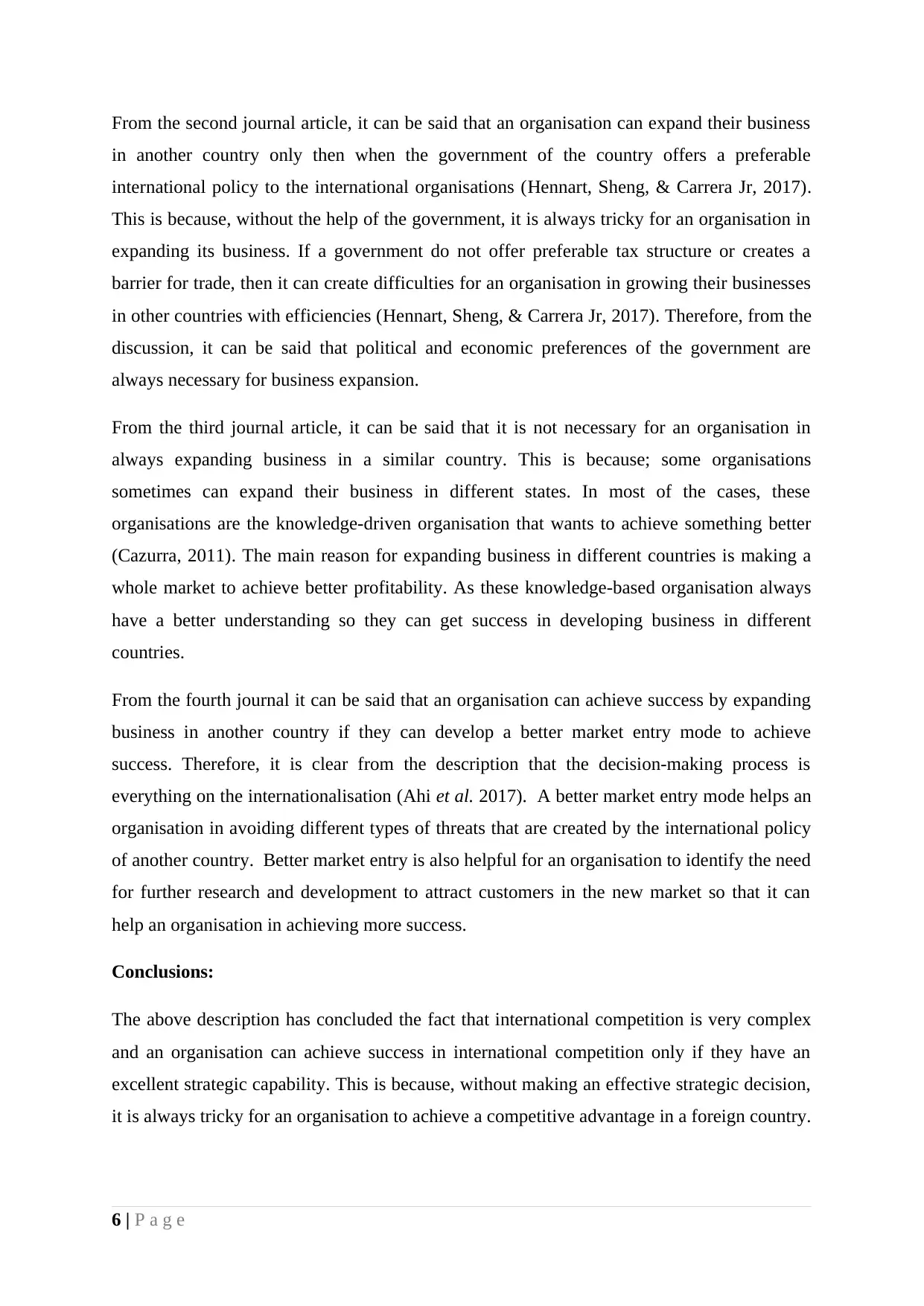
From the second journal article, it can be said that an organisation can expand their business
in another country only then when the government of the country offers a preferable
international policy to the international organisations (Hennart, Sheng, & Carrera Jr, 2017).
This is because, without the help of the government, it is always tricky for an organisation in
expanding its business. If a government do not offer preferable tax structure or creates a
barrier for trade, then it can create difficulties for an organisation in growing their businesses
in other countries with efficiencies (Hennart, Sheng, & Carrera Jr, 2017). Therefore, from the
discussion, it can be said that political and economic preferences of the government are
always necessary for business expansion.
From the third journal article, it can be said that it is not necessary for an organisation in
always expanding business in a similar country. This is because; some organisations
sometimes can expand their business in different states. In most of the cases, these
organisations are the knowledge-driven organisation that wants to achieve something better
(Cazurra, 2011). The main reason for expanding business in different countries is making a
whole market to achieve better profitability. As these knowledge-based organisation always
have a better understanding so they can get success in developing business in different
countries.
From the fourth journal it can be said that an organisation can achieve success by expanding
business in another country if they can develop a better market entry mode to achieve
success. Therefore, it is clear from the description that the decision-making process is
everything on the internationalisation (Ahi et al. 2017). A better market entry mode helps an
organisation in avoiding different types of threats that are created by the international policy
of another country. Better market entry is also helpful for an organisation to identify the need
for further research and development to attract customers in the new market so that it can
help an organisation in achieving more success.
Conclusions:
The above description has concluded the fact that international competition is very complex
and an organisation can achieve success in international competition only if they have an
excellent strategic capability. This is because, without making an effective strategic decision,
it is always tricky for an organisation to achieve a competitive advantage in a foreign country.
6 | P a g e
in another country only then when the government of the country offers a preferable
international policy to the international organisations (Hennart, Sheng, & Carrera Jr, 2017).
This is because, without the help of the government, it is always tricky for an organisation in
expanding its business. If a government do not offer preferable tax structure or creates a
barrier for trade, then it can create difficulties for an organisation in growing their businesses
in other countries with efficiencies (Hennart, Sheng, & Carrera Jr, 2017). Therefore, from the
discussion, it can be said that political and economic preferences of the government are
always necessary for business expansion.
From the third journal article, it can be said that it is not necessary for an organisation in
always expanding business in a similar country. This is because; some organisations
sometimes can expand their business in different states. In most of the cases, these
organisations are the knowledge-driven organisation that wants to achieve something better
(Cazurra, 2011). The main reason for expanding business in different countries is making a
whole market to achieve better profitability. As these knowledge-based organisation always
have a better understanding so they can get success in developing business in different
countries.
From the fourth journal it can be said that an organisation can achieve success by expanding
business in another country if they can develop a better market entry mode to achieve
success. Therefore, it is clear from the description that the decision-making process is
everything on the internationalisation (Ahi et al. 2017). A better market entry mode helps an
organisation in avoiding different types of threats that are created by the international policy
of another country. Better market entry is also helpful for an organisation to identify the need
for further research and development to attract customers in the new market so that it can
help an organisation in achieving more success.
Conclusions:
The above description has concluded the fact that international competition is very complex
and an organisation can achieve success in international competition only if they have an
excellent strategic capability. This is because, without making an effective strategic decision,
it is always tricky for an organisation to achieve a competitive advantage in a foreign country.
6 | P a g e
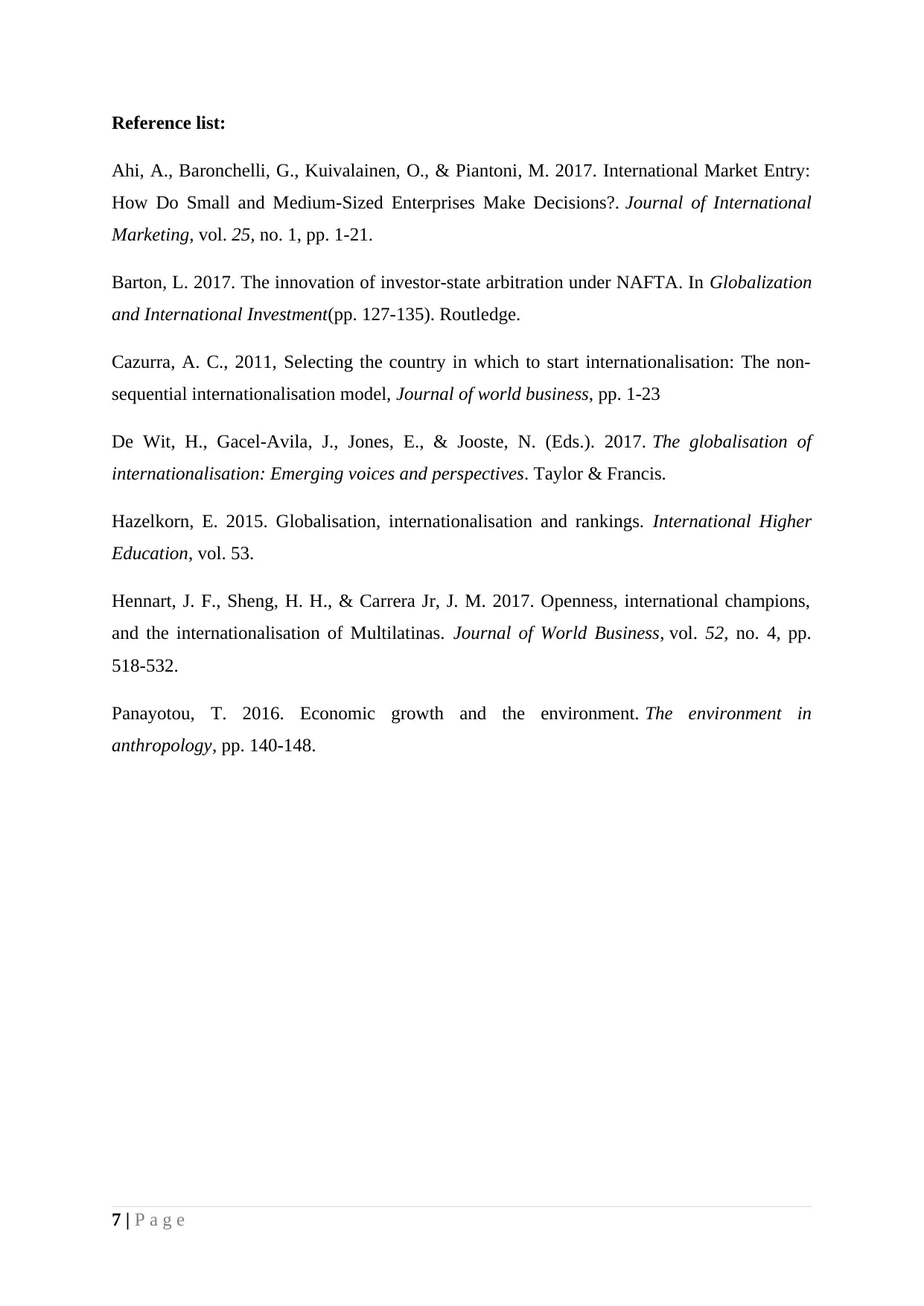
Reference list:
Ahi, A., Baronchelli, G., Kuivalainen, O., & Piantoni, M. 2017. International Market Entry:
How Do Small and Medium-Sized Enterprises Make Decisions?. Journal of International
Marketing, vol. 25, no. 1, pp. 1-21.
Barton, L. 2017. The innovation of investor-state arbitration under NAFTA. In Globalization
and International Investment(pp. 127-135). Routledge.
Cazurra, A. C., 2011, Selecting the country in which to start internationalisation: The non-
sequential internationalisation model, Journal of world business, pp. 1-23
De Wit, H., Gacel-Avila, J., Jones, E., & Jooste, N. (Eds.). 2017. The globalisation of
internationalisation: Emerging voices and perspectives. Taylor & Francis.
Hazelkorn, E. 2015. Globalisation, internationalisation and rankings. International Higher
Education, vol. 53.
Hennart, J. F., Sheng, H. H., & Carrera Jr, J. M. 2017. Openness, international champions,
and the internationalisation of Multilatinas. Journal of World Business, vol. 52, no. 4, pp.
518-532.
Panayotou, T. 2016. Economic growth and the environment. The environment in
anthropology, pp. 140-148.
7 | P a g e
Ahi, A., Baronchelli, G., Kuivalainen, O., & Piantoni, M. 2017. International Market Entry:
How Do Small and Medium-Sized Enterprises Make Decisions?. Journal of International
Marketing, vol. 25, no. 1, pp. 1-21.
Barton, L. 2017. The innovation of investor-state arbitration under NAFTA. In Globalization
and International Investment(pp. 127-135). Routledge.
Cazurra, A. C., 2011, Selecting the country in which to start internationalisation: The non-
sequential internationalisation model, Journal of world business, pp. 1-23
De Wit, H., Gacel-Avila, J., Jones, E., & Jooste, N. (Eds.). 2017. The globalisation of
internationalisation: Emerging voices and perspectives. Taylor & Francis.
Hazelkorn, E. 2015. Globalisation, internationalisation and rankings. International Higher
Education, vol. 53.
Hennart, J. F., Sheng, H. H., & Carrera Jr, J. M. 2017. Openness, international champions,
and the internationalisation of Multilatinas. Journal of World Business, vol. 52, no. 4, pp.
518-532.
Panayotou, T. 2016. Economic growth and the environment. The environment in
anthropology, pp. 140-148.
7 | P a g e
1 out of 7
![[object Object]](/_next/static/media/star-bottom.7253800d.svg)




